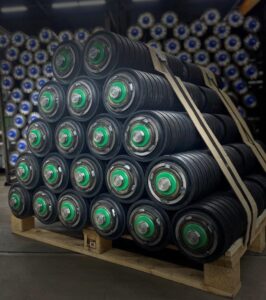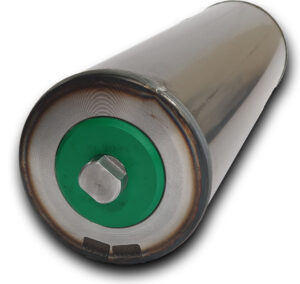What is the difference between medium-duty and heavy-duty conveyor rollers? The difference is not, as you might think, the material, but the wall thickness and the sealing of the conveyor rollers. This makes the medium-duty conveyor roller the perfect roller for sectors such as waste processing, biomass and manufacturing. Stokman’s many years of experience in the design and production of heavy-duty rollers led to a great demand for medium-duty conveyor rollers of the famous Stokman quality. We will use this article to explain the various options.
For decades Stokman has designed and produced heavy-duty conveyor rollers for use in the toughest conditions. These rollers can be found in offshore installations, ships or heavy duty mining. We are known for supplying conveyor rollers of the highest quality.
This is why we frequently receive requests for medium-duty conveyor rollers of the same high quality standard. Now we have used our expertise and knowledge for our brand new medium-duty conveyor rollers. These can be applied in industries such as waste processing, biomass and manufacturing. Medium-duty rollers can be used both outdoors and in more sheltered environments. This article will look into the differences between the heavy-duty and medium-duty conveyor rollers.
Difference between medium-duty and heavy-duty conveyor rollers

- Wall thickness
- Sealing
We will go into these differences in detail.
They are identical in terms of materials used, Stokman produces rolls in steel, sprayed steel, galvanized or stainless steel.
Wall thickness of medium-duty conveyor roller
The minimum wall thickness can be made thinner. Minimum wall thickness of 3.2 mm is possible. To give you an idea, the heavy duty version has a wall thickness of at least 4mm, increasing to 12.5mm. If we start from the most sold series, with a wall thickness of 4 mm, a weight saving of 20% can be achieved on the pipe. This saving results in a lower price per roller.
A lighter roller also reduces the physical strain on the technicians when these rollers change.
Sealing of medium-duty conveyor roller
There are also different sealings. As standard heavy-duty rollers have a unique Stokman seal guaranteeing a long life in the toughest conditions. Medium-duty rollers can be provided with lighter sealings if required. Medium-duty rollers are not used in the harshest conditions, such as on ships. For medium-duty applications, the very highest level of sealing is not necessary.

How do you recognize a medium-duty conveyor roller?
Most medium-duty rollers are manufactured with 30mm shafts. These rollers can be identified by their green sealings. So, if you see a conveyor roller with a green sealing, this as a medium-duty roller with a shaft diameter of 30mm.
Also rollers with a shaft diameter of 20, 40mm can be fulfilled with the medium-duty principle. These rollers can be identified by their distinctive sealing colours.
Conclusion medium-duty:
To technical buyers and designers, both in new buildings and renovations, this introduction of the medium-duty roller offers the proven quality at a more cost-effective price. With this innovation, Stokman expects to attract more market parties in the future. Are you interested in the options, please contact us. We are happy to discuss the best conveyor roller configuration.
Custom made in Raamsdonksveer
Each roller that we engineer and produce can be custom made. So a thinner wall thickness but still the heaviest sealing, or vice versa is always possible. It is this flexibility that has contributed to the Stokman organization celebrating its centenary next year (2022).
“Stokman SCW roles when customer wishes and quality play a role”
